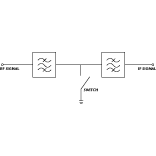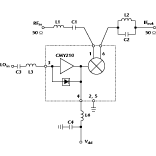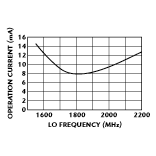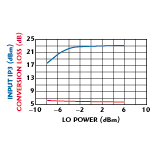A Dual-band AMPS/PCS Duplexer
K&L Microwave Inc.
Salisbury, MD
Competition in the mobile wireless marketplace has become intensely competitive, particularly with the worldwide deployment of the digital communication system (DCS), personal communications service (PCS) and satellite networks. Wireless service providers have responded by making available nationwide (or international, as is becoming increasingly common) roaming agreements that provide seamless, unobstructed coverage for subscribers.
In response to this trend, a dual-band telephone has been developed that can operate at both cellular and DCS or PCS frequencies and currently is being delivered in volume on a global scale. The telephone operates at two separate frequency bands, which necessitates the use of a duplexer product for improved final testing by original equipment manufacturers of dual-band subscriber handsets.
 The model WSA-00045 wireless system assembly is a dual-band Advanced Mobile Phone System (AMPS)/PCS duplexer offering a new and improved method of testing dual-band handsets for next-generation mobile telephones. The assembly contains two duplexers: One operates at AMPS frequencies, providing full-band coverage of both the 824 to 849 MHz receive and 869 to 894 MHz transmit bands; the other is designed for PCS operation, providing full-band receive and transmit frequency coverage at 1850 to 1910 MHz and 1930 to 1990 MHz, respectively. A block diagram of the wireless system assembly is shown in Figure 1 .
The model WSA-00045 wireless system assembly is a dual-band Advanced Mobile Phone System (AMPS)/PCS duplexer offering a new and improved method of testing dual-band handsets for next-generation mobile telephones. The assembly contains two duplexers: One operates at AMPS frequencies, providing full-band coverage of both the 824 to 849 MHz receive and 869 to 894 MHz transmit bands; the other is designed for PCS operation, providing full-band receive and transmit frequency coverage at 1850 to 1910 MHz and 1930 to 1990 MHz, respectively. A block diagram of the wireless system assembly is shown in Figure 1 .
The functional ports of each duplexer in pairs (receive/receive, transmit/transmit and antenna/antenna) are multiplexed such that a common transmission line connection can be made from the receive and transmit test systems and antenna on the dual-band telephone. This configuration eliminates the need for separate filters and/or duplexers to be externally multiplexed with bulky and costly test cables or other miscellaneous components. In addition, the assembly features a 1 dB maximum insertion loss and 40 dB minimum isolation, as shown in Figure 2 , obviating the need to use broadband power dividers. Pass band return loss is 12 dB minimum. Figure 3 shows a typical functional test block diagram.
common transmission line connection can be made from the receive and transmit test systems and antenna on the dual-band telephone. This configuration eliminates the need for separate filters and/or duplexers to be externally multiplexed with bulky and costly test cables or other miscellaneous components. In addition, the assembly features a 1 dB maximum insertion loss and 40 dB minimum isolation, as shown in Figure 2 , obviating the need to use broadband power dividers. Pass band return loss is 12 dB minimum. Figure 3 shows a typical functional test block diagram.
 Each of the assembly’s duplexers is configured using transverse electromagnetic-mode cavity filters, thereby enabling the low maximum insertion loss as well as providing high transmit power handling of 100 W CW, 250 W peak envelope power and 500 W peak instantaneous power. Because of this high power-handling capability, the assembly also can be used in a dual-mode base station application. Depending on the base station’s configuration, either the WSA-00045 assembly’s current configuration can be used or the assembly can be modified using at least two different methods, as shown in Figure 4 . One configuration supports separate receive and transmit
Each of the assembly’s duplexers is configured using transverse electromagnetic-mode cavity filters, thereby enabling the low maximum insertion loss as well as providing high transmit power handling of 100 W CW, 250 W peak envelope power and 500 W peak instantaneous power. Because of this high power-handling capability, the assembly also can be used in a dual-mode base station application. Depending on the base station’s configuration, either the WSA-00045 assembly’s current configuration can be used or the assembly can be modified using at least two different methods, as shown in Figure 4 . One configuration supports separate receive and transmit  signals; the other supports duplexed receive and transmit signals.
signals; the other supports duplexed receive and transmit signals.
Additional configurations similar to the current WSA-00045 wireless system assembly can be supplied as well. For example, alternate models can be supplied that provide coverage for the Global System for Mobile communications receive and transmit bands at 880 to 915 MHz and 925 to 960 MHz, respectively, and the DCS receive and transmit bands at 1710 to 1785 MHz and 1805 to 1880 MHz, respectively.
The WSA-00045 dual-band duplexer is packaged in a 10.1" x 4.6" x 2.4" housing (excluding connectors) and is supplied with type-N female connectors. The assembly operates from 0° to +50°C at 0 to 90 percent noncondensing humidity. Delivery lead time is eight to 10 weeks ARO and the manufacturer is able to support large-quantity shipments. Additional information can be obtained from the company’s Web site at http://www.klmicrowave.com or via e-mail at wireless@klmicrowave.com.
K&L Microwave Inc.,
Salisbury, MD
(410) 749-2424.
